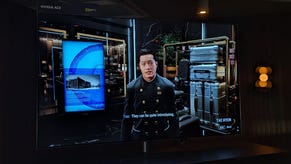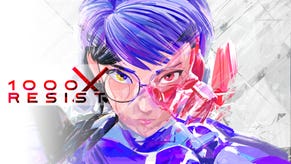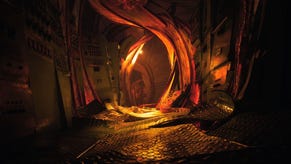Retro JRPG Chained Echoes has all the makings of a modern classic
We chat to solo dev Matthias Linda about the 7-year development journey of his debut game
Matthias Linda is feeling tense. Chained Echoes, the retro Japanese-inspired RPG he's been working on as a solo dev for the last seven years, is almost ready to release on Steam, but he tells me there's "still so many little and not so little things to do" before the big day hits on December 8th. "[I] still need to patch the languages into the console versions. Still need to pass one submission," he says over email. "I can’t really think about the release itself, just about the things I need to finish till then."
But he also says he's "happy at the same time". After a successful Kickstarter campaign in 2019, Chained Echoes has been gradually gathering steam ever since - and judging by the 90-minute demo I was able to play recently, it's clear Linda's got something really quite special here. Not only do its 16-bit-style visuals look absolutely stunning, but its turn-based combat's also unlike anything else I've seen. You've still got your classic list of commands to pick from, but as battles progress you'll need to maintain a kind of flow state known as Overdrive to deal the optimum amount of damage. Overextend your party's abilities and you'll leave yourself vulnerable to critical hits from your enemies, but go too slow and you'll need to build your Overdrive bar back up to regain those lost stat buffs. It's a fascinating system, and was borne out of Linda's desire to "build a bridge between the worlds" of considered, turn-based tactical combat and the fast-paced action of real-time.
Linda grew up making fangames with RPG Maker when he was younger, he tells me. "Like, fangames in the vein of Final Fantasy VI. I never released them, but it was my passion. I always wanted to create something worthy of the games I grew up [with]. That's how the game came to life, I guess."
Among those games of his childhood are some of the most beloved JRPGs of the SNES and PS1 era: Xenogears, Terranigma, Secret Of Mana, Suikoden 2, Breath Of Fire, Legend Of Dragoon and, of course, Final Fantasy VI. "They all influenced me as a child, and they influenced Chained Echoes," Linda says. "Xenogears the most, that's for sure. […] Don’t get me wrong, I love JRPGs from today but those from my childhood, they will always be special to me."
Indeed, take one look at Chained Echoes and it's plain to see how those games have left their mark on Linda's war-torn world of Valandis. This is a land where magic, mechs and airships all jostle together in a convincing mesh of medieval fantasy, and where your large, wide-ranging party offers plenty of nuance and personality in the way you travel through it. In the demo alone, I counted seven playable party members in the game's opening 90 minutes, ranging from swordsmen and archers, to thieves and spear wielders, and the trailer above suggests there are still plenty more waiting in the wings.

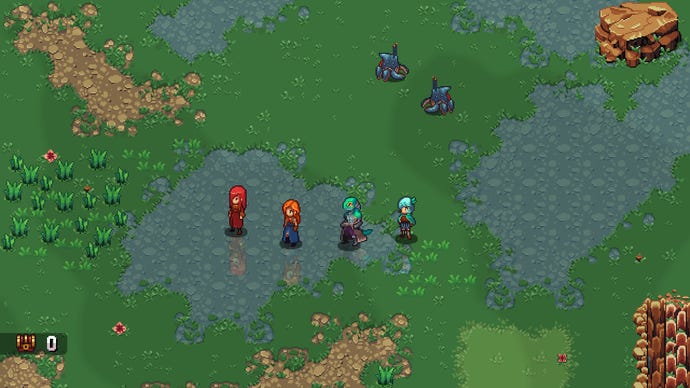
.png?width=690&quality=80&format=jpg&auto=webp)
"But I never tried to copy them," Linda insists. "I tried to copy what I remembered about them. Copy might be the wrong word here though, but you get the idea. Thing is, in my head, all these games look and play better than they actually did. Some didn’t even age well. But in my head, they are still amazing. And I tried to recreate what I had in my head. Not how they actually were. And I think I’m not alone with my wish to have something like that today. I think that did the job."
"In my head, all these games look and play better than they actually did. [...] And I tried to recreate what I had in my head. Not how they actually were."
Of course, with an estimated run-time of 30-40 hours, it's hard to judge from those initial 90 minutes whether Linda's been successful here. One thing's certain though - Chained Echoes wastes no time in establishing its key party members, and its brisk introduction to the game's three warring factions and their quest to take control over the mysterious Opus Stone makes for a refreshing change of pace compared to other modern day SNES-style RPGs I've played recently.
Indeed, it would certainly seem like Linda's taken the right lessons from the JRPGs he enjoyed in his youth, even if it's taken longer than expected to bring them to fruition. While development started in earnest in 2016, Linda says he first started thinking about Chained Echoes a year earlier. "The first year was mostly laying out the storyline and all that," he says, and amazingly, the version of the game that's realising on December 8th is pretty much exactly "what [he] had in mind when all this started". Even with the additional funds brought in from its 2019 Kickstarter, Linda tells me the scope of the game "didn't really blow up" in any way, and that the only casualty of its extended development period was not being able to include multiple endings to tie in with its story-based decision making.
"Sadly I skipped that part," he says. "There are tons of decisions in the game and sometimes the player can go this way or another first. But there are no decisions which will change the ending of the game or the story. I wanted to have that in the first place, but realised that such influential decisions would hurt the story. I wanted to deliver something with a meaning, something with a message. And I can’t communicate my message if I have to split it up. A sacrifice I had to make."
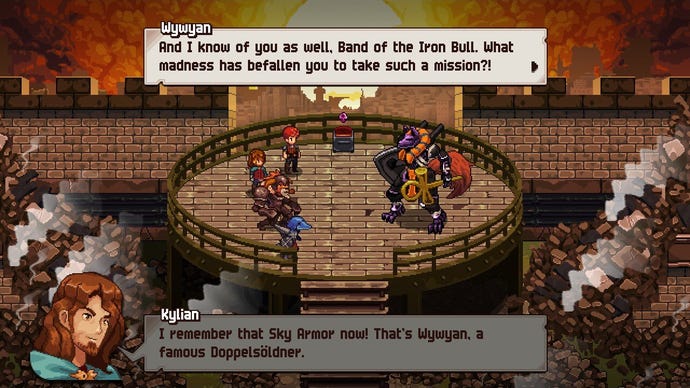
Still, even if Chained Echoes doesn't go full Chrono Trigger in the end, it still has one other key thing in common with Square's time-travelling classic, and that's no random encounters whatsoever. Instead, all enemies are visible on the map from the off. Of course, several modern JRPGs have since followed in Chrono Trigger's pioneering footsteps, but it's also a point Linda hammers home quite prominently on both the game's Steam page and its old Kickstarter page, and so I asked Linda what his thoughts were on them. Even as a long-time JRPG-liker myself, I've never been much of a fan of random battles either, so I was curious if Linda felt the same.
"Random encounters were a technical limitation back in the days," says Linda. "The systems just couldn’t display so many things at the same time […] I never really liked how they were executed, and I know tons of other players dislike the system as well. There are approaches where I really like them, however. The developer behind Full Circle from Peru, he is implementing a warning system for the random encounters, so when you get closer to an enemy, you will still know [it's coming]. I like that idea. But for my game… well, I wanted the world to be filled with monsters and technically I was able to do that."


Indeed, in the demo, battles came thick and fast, providing plenty of time to get to grips with its intriguing Overdrive system. As I mentioned above, this involves using attacks and abilities that both add and subtract from your Overdrive bar to help keep your party 'in the zone', so to speak. Building it up is easy, as every attack will add a bit more to the bar until you eventually hit its optimal green zone. Here, you'll not only do more damage to enemies, but you'll also get a boost to your defence and half the TP cost of your party's special attack skills.
Making sure your party doesn't Overheat in the process, though, that's the hard part. Luckily, there are certain attack types you can use to bring the Overdrive bar back under control. The catch? These types will change every couple of turns, so you'll need to keep an eye on the little icon in the top left of the screen (or watch out for special attacks marked in yellow) to know which ones you'll need to select to prevent you from going into the red. You can also lower the Overdrive bar by defending or using one of your character's Ultra Moves (a Final Fantasy-style Limit Break by another name) if it's at full charge.
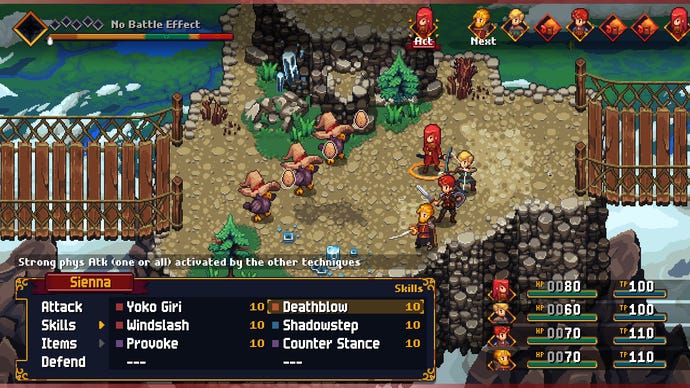
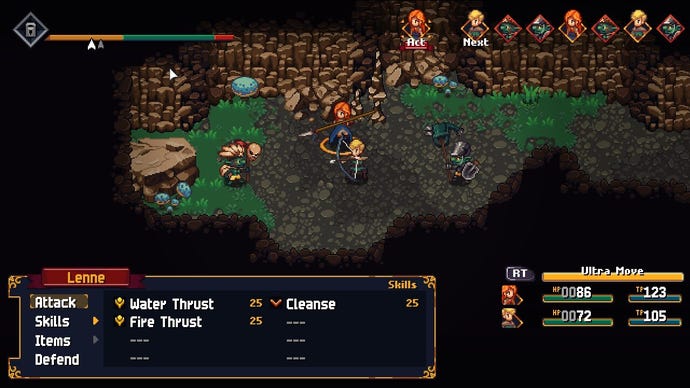
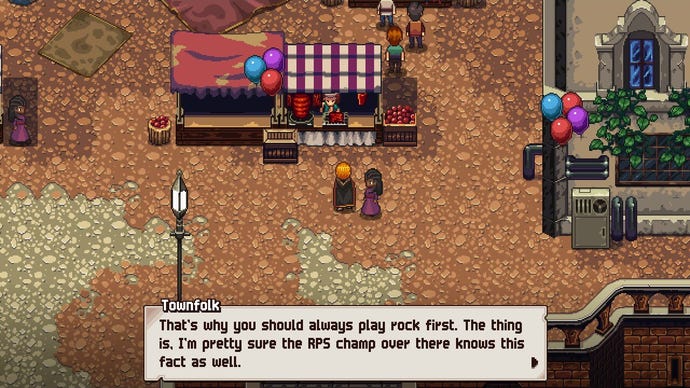
That might sound complicated written down, but in practice it's a thrilling, tactical dance of offence and defence. You're constantly weighing up how to adapt your plan of attack to keep that Overdrive bar in the green, and it helps to keep battles feeling lively and entertaining. It also means no two scraps are ever really the same - which is important when you're spending 30-40 hours with a game like this - as using the same strategies over and over again will have you teetering into the Overheat zone in no time at all. And with the demo constantly cycling in new characters and job classes, there was plenty to get to grips with, too.
Again, it's difficult to say at this point whether its battle system will evolve any further during the game, but based on what I've played so far, it certainly feels like Chained Echoes has taken all the right lessons from its 16-bit inspirations. It feels modern and nostalgic at the same time, and had this released alongside those late 90s classics, I have a feeling we'd be talking about it now in very much the same breath as Chrono Trigger, Final Fantasy VI and everything else. Perhaps I'm getting ahead of myself a bit there, but seriously, there is something special here, and you should definitely keep an eye on it if SNES-era JRPGs are your jam.
As a final question to Linda, I asked him how he felt about modern JRPGs and whether they've strayed too far from their roots these days. While you've still got big tentpole series such as Dragon Quest flying the flag for the old-school, other big blockbusters such as Final Fantasy are straying ever further into the realms of real-time action games with each successive entry. It's left something of a vacuum in the JRPG genre over the last ten years or so, and it's one that smaller developers like Linda and other retro-focused studios, including Square Enix subsidiary Tokyo RPG Factory, have been trying to fill ever since. Thankfully, we're now starting to see the fruits of those labours, although some have been more successful than others at recapturing what made those earlier games so memorable.

"They… definitely took another route," says Linda. "But genres evolve. That’s fine. I still love quite a bunch of modern JRPGs. The route I am taking, and which others are too… I don’t know. I’d bet we all grew up in similar times. And we’re all in the age now where we develop games for a living. Or we hope to make a living of it. That is my explanation. I love the fact that I’m not alone out there and I’m looking forward to quite a bunch of comparable games."
So yes, in some ways, it's not surprising Linda's feeling some pre-release jitters at the moment, but I think he's got plenty to be proud of, too. "I am happy that the Kickstarter backers give me super positive feedback on each and every aspect of the game, and I still love the soundtrack [composed by Eddie Marianukroh]," he says. "But I am happy that soon the game is out and I don’t need to check everything everyday again."
Chained Echoes is out on Steam on December 8th, and you can look forward to some more in-depth impressions from us then.



